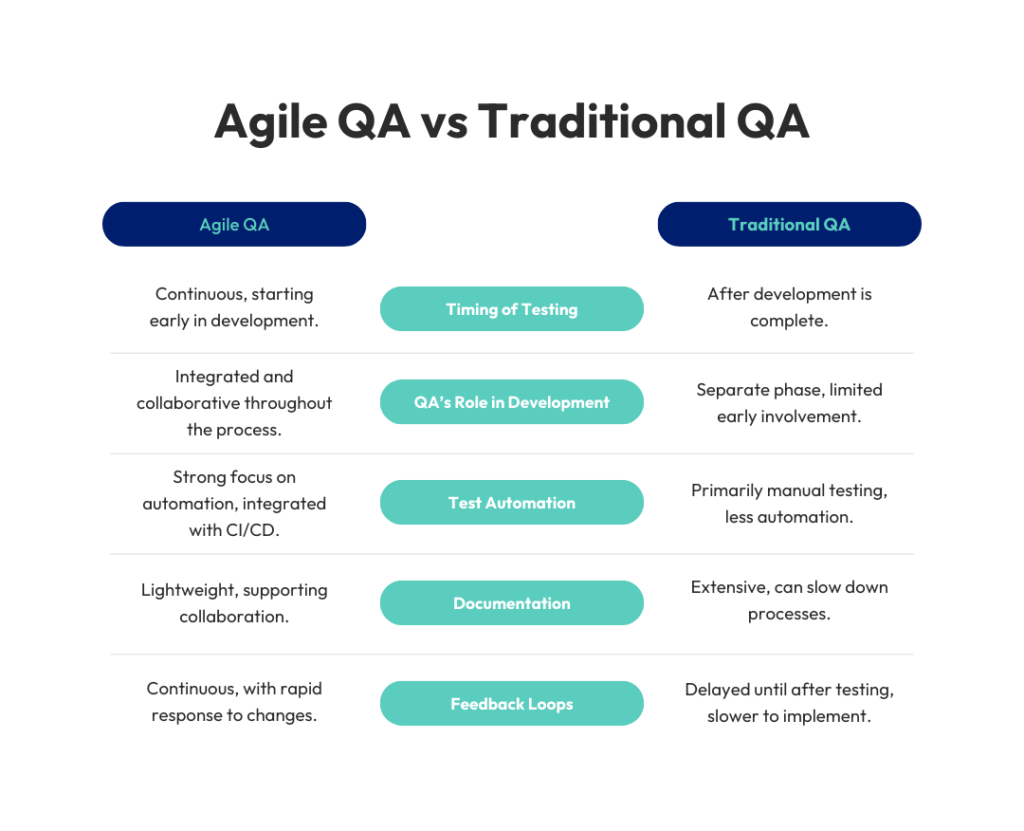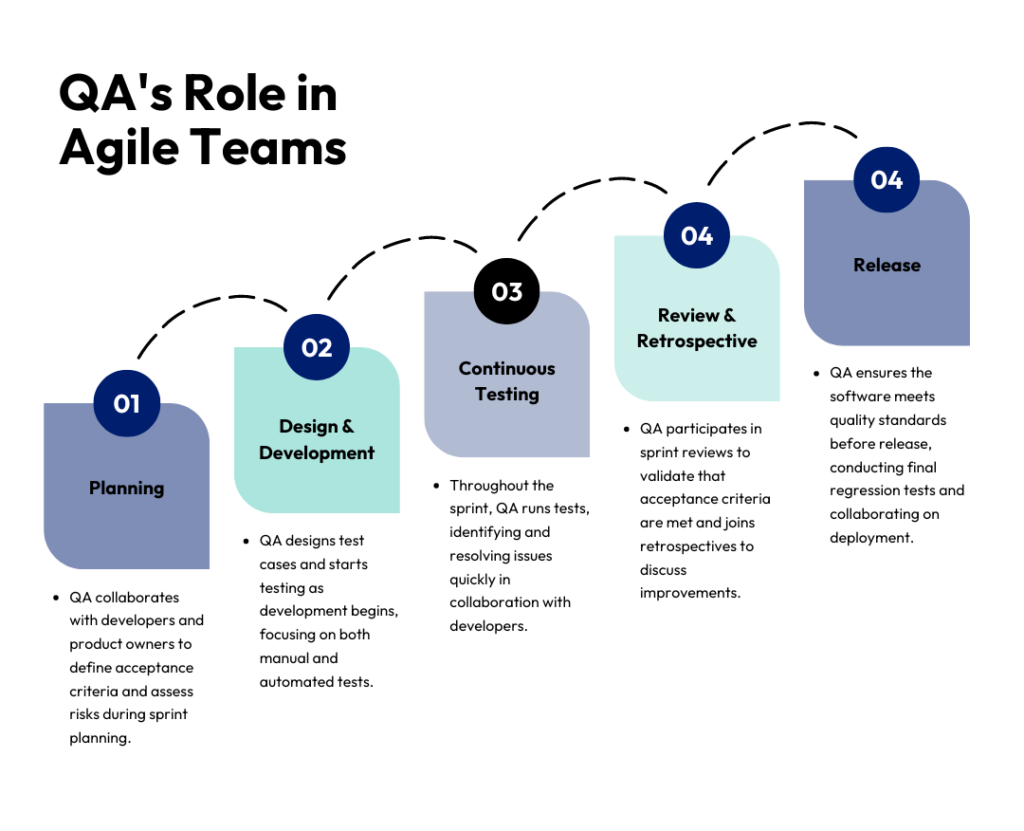Quality Assurance (QA) is essential to delivering high-quality software that meets customer needs. But as the software industry rapidly evolves, so too must the methods we use to ensure quality. If you’re still relying on traditional QA processes, you might be missing out on the speed, flexibility, and collaboration that Agile QA offers.
This guide will walk you through the role of QA in Agile, why your business should consider making the switch, and how to effectively implement Agile QA in your development process. Whether you’re a startup looking to accelerate your product development or an established enterprise aiming to improve your software quality, this guide is for you.
What is the Role of QA in Agile?
In a traditional software development model, QA usually comes at the end of the development cycle, often causing bottlenecks and last-minute fixes. In Agile, QA is integrated into every stage of the process, ensuring quality is baked in from the very start.
Why QA is Crucial in Agile
- Collaboration from Day One: QA teams work alongside developers and stakeholders from the beginning, participating in planning sessions, daily stand-ups, and retrospectives. This close collaboration helps ensure that everyone is aligned on project goals and quality standards.
- Early Issue Detection: With Agile, testing starts as soon as development begins. This shift-left approach allows your team to catch potential issues early, reducing the time and cost of fixes later on.
- Automation: Agile emphasizes test automation, integrating automated tests into the continuous integration/continuous delivery (CI/CD) pipeline. This not only speeds up the feedback loop but also ensures that every code change is automatically tested.
- Customer-Centric Development: QA in Agile focuses on meeting customer needs by validating user stories against acceptance criteria, ensuring the final product is exactly what the customer wants.
- Continuous Improvement: Agile is iterative, and so is its QA process. Regular retrospectives allow teams to reflect on what worked, what didn’t, and how they can improve in the next sprint.
Why Your Business Should Switch to Agile QA
1. Accelerated Time-to-Market
Agile methodologies are designed for speed. By embedding QA throughout the development process, your team can identify and resolve issues faster, allowing you to release products more quickly. This accelerated time-to-market can give your business a competitive edge, particularly in fast-paced industries.
2. Superior Product Quality
With Agile QA, quality isn’t just checked at the end—it’s ensured at every step. This proactive approach to quality management results in fewer defects, more reliable software, and ultimately, happier customers.
3. Enhanced Collaboration
In Agile, QA isn’t a separate function—it’s part of the team. This integration fosters better communication between developers, testers, and product owners, leading to a more cohesive and productive development process. It also means that QA has a voice in planning and can influence how features are built and tested.
4. Flexibility to Adapt
Agile is inherently flexible, allowing your team to pivot when requirements change or new opportunities arise. Agile QA adapts to these changes seamlessly, ensuring that your product remains on track and aligned with business goals.
5. Continuous Customer Feedback
6. Cost-Effective Development
How Agile QA Differs from Traditional QA
If you’re considering transitioning to Agile QA, it’s important to understand how it differs from traditional QA methodologies. These differences highlight the benefits of Agile and why it might be the right choice for your business.

1. Timing of Testing
- Traditional QA: Testing is typically conducted after development is complete, often leading to delays and rushed fixes.
- Agile QA: Testing happens continuously throughout the development process, ensuring issues are identified and resolved early.
2. QA’s Role in Development
- Traditional QA: QA operates as a separate entity, often with limited interaction with developers until the testing phase.
- Agile QA: QA is embedded within the development team, collaborating with developers and product owners from the start. This results in a more cohesive and proactive approach to quality.
3. Test Automation
- Traditional QA: Automation is often an afterthought, with a heavy reliance on manual testing.
- Agile QA: Test automation is a cornerstone of Agile, enabling faster, more reliable testing and reducing the risk of human error.
4. Documentation
- Traditional QA: Extensive documentation is common, which can slow down the process and create bottlenecks.
- Agile QA: Agile takes a more streamlined approach to documentation, focusing on what’s necessary to support collaboration and effective testing.
5. Feedback Loops
- Traditional QA: Feedback is often delayed until the end of the development cycle, making it harder to implement changes.
- Agile QA: Continuous feedback is integral to Agile, with regular check-ins and updates ensuring the product is on track.
How QA Works Within Agile Teams

1. Planning Phase
QA starts at the very beginning of the Agile process. During sprint planning, QA professionals collaborate with developers and product owners to review user stories, define acceptance criteria, and identify potential risks. This ensures that everyone is on the same page and that testing is aligned with business goals.
2. Design and Development Phase
As development kicks off, QA teams begin designing test cases based on the agreed-upon acceptance criteria. This might involve writing automated tests that will run as part of the CI/CD pipeline or preparing for manual testing of more complex scenarios.
3. Continuous Testing Phase
Throughout the sprint, QA teams continuously test new code as it’s developed. This could involve running automated tests, performing manual tests, or conducting exploratory testing to catch edge cases that predefined tests might miss. This ongoing testing ensures that issues are identified and resolved quickly, keeping the project on track.
4. Review and Retrospective Phase
At the end of the sprint, QA teams participate in review meetings to showcase what has been tested and ensure all acceptance criteria have been met. They also take part in retrospective meetings to discuss what went well, what could be improved, and how to optimize the QA process moving forward.
5. Release and Deployment Phase
Before a release, QA teams ensure that all necessary tests have been completed and that the software meets the required quality standards. They work closely with the development and operations teams to ensure a smooth deployment and often conduct final regression tests to confirm that no issues have been introduced.
Principles of Agile QA
Agile QA is guided by several key principles that ensure quality is maintained throughout the development process. Understanding these principles can help your business successfully implement Agile QA.
1. Quality is a Shared Responsibility
In Agile, quality isn’t just the concern of the QA team—it’s everyone’s responsibility. Developers, product owners, and other stakeholders all play a role in ensuring the product meets the required standards.
2. Customer-Focused Testing
3. Early and Continuous Testing
4. Automation and Continuous Integration
5. Collaboration and Communication
6. Adaptability and Flexibility
Key Steps in Implementing Agile QA

1. Requirement Analysis
2. Test Planning
3. Test Design
4. Test Execution
5. Defect Management
6. Regression Testing
7. Review and Feedback
8. Retrospective and Continuous Improvement
How to Choose the Right Agile QA Method for your Business
1. Test-Driven Development (TDD)
2. Behavior-Driven Development (BDD)
3. Acceptance Test-Driven Development (ATDD)
4. Exploratory Testing
5. Continuous Integration/Continuous Deployment (CI/CD)
Transform Your QA Process Today!
How to Measure the Success of your Agile QA Process
1. Test Coverage
2. Defect Density
Defect density measures the number of defects per unit of code or functionality. A lower defect density indicates higher code quality and a more effective QA process. Tracking defect density can help your business identify areas for improvement and ensure that your software meets high-quality standards.
3. Defect Resolution Time
Defect resolution time measures how quickly defects are resolved. In Agile, where rapid iteration is key, shorter resolution times indicate a more efficient QA process. This metric helps ensure that issues are addressed quickly, keeping your project on schedule.
4. Test Execution Time
5. Customer Satisfaction
6. Sprint Velocity
Best Practices for Implementing Agile QA in Your Business
1. Foster Collaboration
2. Invest in Automation
3. Prioritize Early Testing
Start testing as early as possible in the development process. This shift-left approach helps catch issues early, reducing the time and cost of fixes later on. Encourage developers to write tests as part of their coding process and integrate testing into your sprint activities.
4. Focus on Test Quality
High test coverage is important, but test quality is equally crucial. Ensure that your tests are well-designed, reliable, and focused on validating critical functionality. Regularly review and refine your test cases to eliminate redundant or low-value tests.
5. Incorporate Exploratory Testing
6. Continuously Review and Improve
Agile is all about continuous improvement. Regularly review your QA process, tools, and practices during retrospectives, and identify areas for enhancement. Encourage a culture of experimentation and learning, where the team is constantly looking for ways to improve efficiency and effectiveness.
7. Align QA with Business Goals
Ensure that your QA activities are aligned with your business goals and objectives. Focus on delivering value to the customer, and prioritize testing activities that contribute to achieving those goals. Regularly engage with stakeholders to ensure that the product is meeting their needs and expectations.
8. Build a Culture of Quality
Quality should be embedded in every aspect of your development process. Foster a culture where quality is everyone’s responsibility, and where QA is seen as an integral part of delivering high-quality software. Encourage team members to take ownership of quality and to proactively identify and address issues.
Why Agile QA is a Smart Move for Your Business
The role of QA in Agile is dynamic and crucial to delivering high-quality software quickly. By adopting Agile QA, your business can benefit from faster time-to-market, improved product quality, and enhanced collaboration. However, transitioning to Agile QA can be challenging, especially if you’re accustomed to traditional methods.
Outsourcing your QA can streamline this transition. If you need help in elevating your QA process, our experienced QA team is well-versed in Agile practices and can help you implement efficient, cost-effective QA processes that align with your business goals.
Contact us today, and let us help you deliver software that meets your customers’ needs and drives your business forward.


